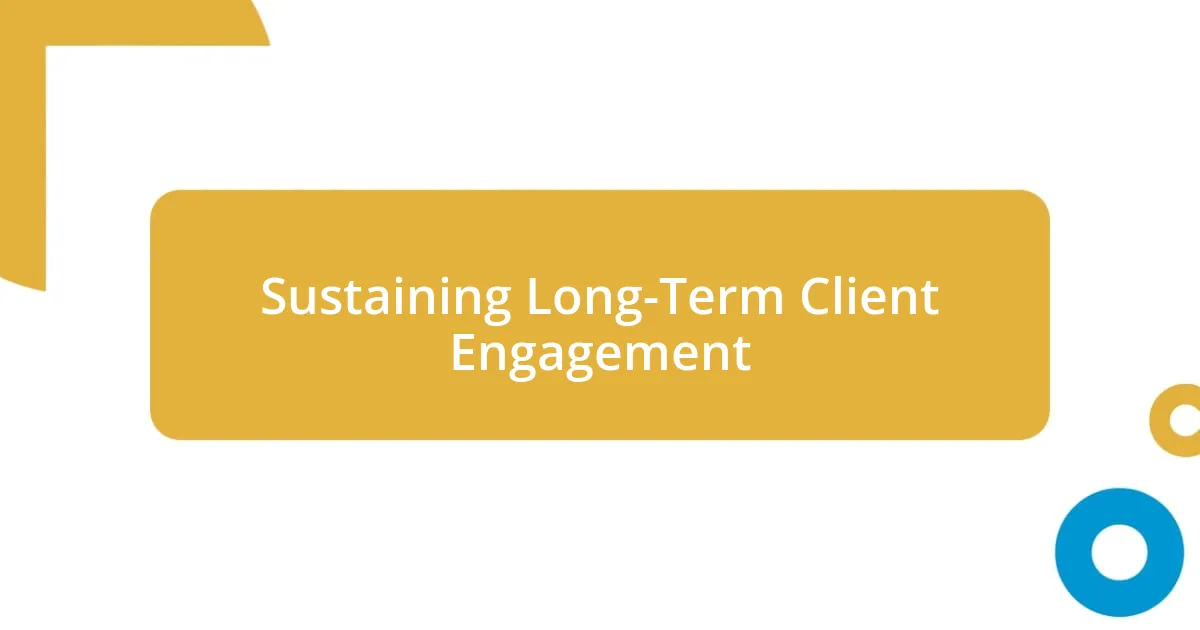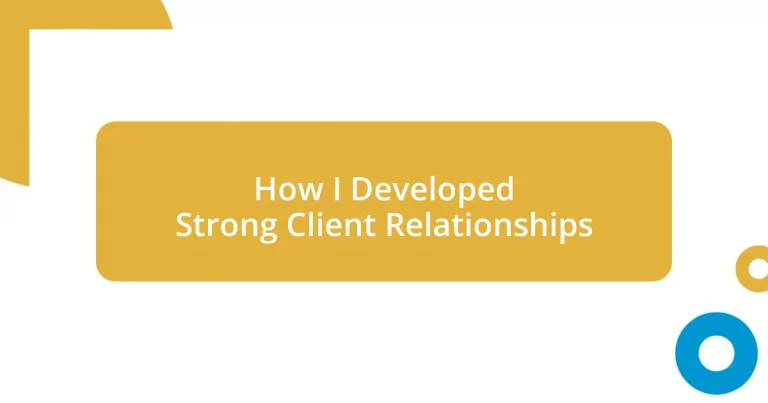Key takeaways:
- Active listening and empathy are crucial for understanding client needs, fostering trust and loyalty.
- Building trust involves transparent communication, consistency, and creating a safe environment for open dialogue.
- Personalizing interactions and providing value beyond expectations can transform client relationships into lasting partnerships.
- Handling difficult situations with composure and transparency can strengthen relationships and demonstrate commitment to resolution.

Understanding Client Needs
Understanding client needs is a journey that requires active listening and empathy. I remember a time when a client expressed frustration not just with a project’s deadline but with feeling overlooked in our communications. That moment opened my eyes to the importance of not just hearing, but truly understanding what lay beneath the surface of their concerns.
Have you ever had a conversation where you felt more like a transaction than a trusted partner? I have, and it taught me that building strong relationships hinges on engaging clients in meaningful dialogue. It’s essential to ask open-ended questions that prompt clients to share their goals and motivations. For instance, asking “What inspired you to start this project?” allows them to reveal their passion, giving me greater insight into how best to support them.
I often revisit previous client conversations to uncover recurring themes in their responses. This practice deepens my understanding and helps me tailor my approach for continuous improvement. When clients see that I genuinely understand their needs, it fosters trust and loyalty, ensuring they feel valued and supported throughout our collaboration.

Building Trust Through Communication
Building trust is the foundation of any successful client relationship, and effective communication is at the heart of that trust. I learned this firsthand when a client once confided in me during a mid-project check-in. Their candid feedback made me realize that I hadn’t been proactive enough in sharing updates. By opening up that channel of communication, I not only addressed their concerns but strengthened our partnership. It was a turning point that taught me the power of transparency.
Another essential aspect of building trust is being consistent in communication. I’ve found that clients appreciate regular, scheduled updates rather than waiting for them to reach out. I remember designing a bi-weekly email summary highlighting project progress, challenges, and next steps. This small adjustment transformed how my clients viewed our collaboration. They felt informed and included, which in turn deepened their trust in my commitment to their success.
Finally, I believe in the importance of creating an environment where clients feel safe to share their thoughts and emotions. I once had a situation where a client hesitated to voice their doubts about a project direction. After encouraging open discussions, they shared their hesitations, leading to adjustments that improved outcomes. It reaffirmed my belief: when clients know they can express themselves freely, it paves the way for a more authentic and trustworthy relationship.
| Element | Importance |
|---|---|
| Transparency | Encourages openness and proactive issue resolution. |
| Consistency | Builds reliability and keeps clients informed about progress. |
| Safe Environment | Fosters honest dialogue and strengthens emotional connections. |

Implementing Effective Follow-Up Strategies
Implementing effective follow-up strategies is where the real magic happens in nurturing client relationships. I’ve often experienced the impact of a simple, timely check-in. For example, after a project wraps up, sending a personalized thank-you email and a quick survey to gauge their experience can go a long way. It not only shows that I value their feedback but also opens the door for future collaborations. This kind of follow-up helps clients feel appreciated and encourages ongoing dialogue.
- Personalized Messages: Tailor your follow-up to the client’s specific needs or project outcomes.
- Feedback Requests: Ask questions that invite their opinions on what went well and what could be improved.
- Next Steps: Use follow-ups to suggest future projects or opportunities to work together again.
It’s interesting how a small gesture can leave a lasting impression. I once followed up with a client who had a positive experience with my service. I never expected it would lead to them referring me to another business that needed help. This experience reinforced my belief that consistent follow-ups not only maintain the relationship but can also lead to unexpected opportunities for growth. Building that consistent touchpoint allows me to stay engaged with my clients, making them feel valued and understood in the long run.

Personalizing Client Interactions
Personalizing client interactions is all about making each client feel special and understood. I remember a time when I noticed a client mentioning their love for a particular coffee brand during one of our meetings. The next time we met, I brought along a little gift bag with a few samples. Their surprise and delight showed me that these small, thoughtful gestures can significantly enhance the personal connection we share.
In my experience, utilizing clients’ names and remembering details about their lives or preferences can transform routine interactions into meaningful conversations. During a recent check-in, I casually asked about a client’s upcoming vacation, which sparked an excited discussion. This moment made me realize how genuinely taking an interest in their lives can foster trust and loyalty.
Moreover, adapting my communication style to match that of the client has proven invaluable. Some clients prefer concise, data-focused updates, while others connect better through storytelling. By recognizing these differences, I can tailor my interactions to meet their preferences. It’s fascinating how showing genuine interest in who they are and how they communicate can elevate the client experience to a whole new level.

Providing Value Beyond Expectations
Providing value beyond expectations isn’t merely about delivering results; it’s about anticipating needs before they even arise. There was a time when I identified a gap in a client’s strategy while working on a project. I took the initiative to create an additional report highlighting potential opportunities they hadn’t considered. Their gratitude was palpable, and they appreciated my proactive stance. It’s remarkable how a little foresight can turn a regular client relationship into a partnership built on trust.
When I strive to offer value, I often think about the art of going that extra mile. I once made a small investment in a resource that could help a client improve their workflow efficiency, along with a brief guide I created outlining how to implement it. Much to my surprise, their response was overwhelmingly positive—they not only implemented my suggestions but also found ways to enhance their own processes further. In that moment, I realized that genuine investment in a client’s success creates a collaborative spirit that’s incredibly rewarding.
Have you ever contemplated what your clients might need even before they express it? This mindset is powerful and can redefine your relationship. I often tune in to industry trends and generate insights relevant to my clients. During a casual conversation about an emerging technology, I shared an article that predicted significant shifts in their sector. Their excitement over discussing how to adapt illustrated the deep connection we had formed. By offering information and guidance that aligns with their goals and challenges, I can help cultivate an enduring partnership grounded in genuine support.

Handling Difficult Situations Gracefully
Handling difficult situations gracefully requires a blend of empathy and composure. I once faced a challenging scenario when a client was unhappy with the direction of a project we were working on together. Instead of becoming defensive, I chose to listen actively to their concerns. Their frustration was palpable, but I focused on understanding their perspective. This approach not only diffused tension but opened the door for a constructive dialogue that ultimately strengthened our relationship.
Navigating conflicts also means being transparent about challenges while emphasizing solutions. I recall a time when I missed a deadline due to unforeseen circumstances. Rather than hiding the mistake, I reached out to my client, explained the situation candidly, and proposed a revised timeline. They appreciated my honesty and willingness to rectify the situation, turning what could have been a fallout into an opportunity to build trust.
Have you ever been in a situation where keeping calm felt impossible? In those moments, I remind myself of a strategy I developed: take a deep breath and reframe the issue as a shared problem to solve, rather than a personal failure. This mentality allows me to approach difficult conversations with a collaborative spirit. I find that when I admit challenges and express my commitment to finding a resolution, my clients are much more likely to be understanding and supportive.

Sustaining Long-Term Client Engagement
Maintaining strong client engagement over time is a delicate balance of communication and genuine interest. I remember a client who initially only reached out for quarterly check-ins, but I sensed a golden opportunity to deepen our connection. During one of our casual chats, I casually asked how their recent project was progressing. They opened up about some struggles, which surprised me; I was glad to provide some specific insights that directly addressed their concerns. Turning those conversations into regular touchpoints transformed our relationship, evolving it from obligatory check-ins to impactful discussions.
Another critical aspect I’ve found is the importance of celebrating milestones, both significant and small. I once sent a handwritten note when a client hit a critical sales target. The gratitude in their response was more than just appreciation; they felt recognized. This small gesture reminded them of our partnership and solidified their trust in me as more than just a vendor. Have you thought about how gratitude can foster loyalty? I often think back to that moment, realizing that these little acknowledgments go a long way in anchoring a lasting connection.
Being proactive in sharing relevant insights further sustains client engagement. I make it a point to follow industry trends, curating articles or resources that might resonate with their evolving needs. I remember sharing a webinar that I found particularly enlightening, which sparked an exciting discussion about future strategies. Not only did it keep our project aligned with new trends, but it also reinforced that I was invested in their long-term success. By consistently reinforcing my commitment, I’m reminded of how much deeper client relationships can grow when we take the time to connect authentically.














